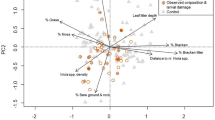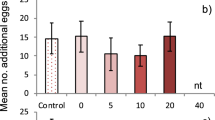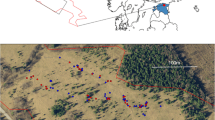Abstract
Knowledge of density-dependent processes and how they are mediated by environmental factors is critically important for understanding population and community ecology of insects, as well as for mitigating harmful insect-borne diseases. Here, we tested whether the oviposition of chironomids (Diptera: Chironomidae; non-biting midges), known to carry the Cholera pathogen Vibrio cholerae, is density dependent and if it is mediated by habitat availability. We used two multiple choice experiments in habitat-limited and habitat-unlimited environments and performed isodar analysis on counts of egg batches after controlling the polarization of light reflected from the habitats, which is known to affect their attractiveness to ovipositing chironomids. We found that, when habitats are limited, egg batch isodars indicate that chironomid selection is density dependent. Although a greater number of individuals selected to oviposit in highly polarized sites, oviposition was also common in sites with low polarization. When habitats are unlimited, chironomid selection is either weakly density dependent, or completely density independent. Chironomids oviposit to a very large extent in sites with high level of polarization, oviposit to a small extent in sites with medium level of polarization, and almost completely disregard unpolarized sites. We suggest that ovipositing females consider the availability of habitats in their surroundings when they choose an oviposition site. When high quality habitats are scarce, more females opt to breed in low quality sites. These findings may be used to limit the spread of Cholera by controlling the habitats available for chironomid oviposition.



Similar content being viewed by others
References
Armitage PD, Cranston PS, Pinder LCV (1995) The chironomidae: the biology and ecology of non-biting midges. Chapman & Hall, London
Broza M, Halpern M (2001) Pathogen reservoirs—chironomid egg masses and Vibrio cholerae. Nature 412:40–41
Broza M, Gancz H, Halpern M, Kashi Y (2005) Adult non-biting midges: possible windborne carriers of Vibrio cholerae non-O1 non-O139. Environ Microbiol 7:576–585
Broza M, Gancz H, Kashi Y (2008) The association between non-biting midges and Vibrio cholerae. Environ Microbiol 10:3193–3200
Calsbeek R (2009) Experimental evidence that competition and habitat use shape the individual fitness surface. J Evol Biol 22:97–108
Charnov EL (1976) Optimal foraging, the marginal value theorem. Theor Popul Biol 9:129–136
Crump ML (1991) Choice of oviposition site and egg load assessment by a treefrog. Herpetologica 47:308–315
Devereaux JSL, Mokany A (2006) Visual and chemical cues from aquatic snails reduce chironomid oviposition. Aust J Zool 54:79–86
Dia-Eldin AE, Ward RD (1991) Response of the sandfly Lutzomyia longipalpis to an oviposition pheromone associated with conspecific eggs. Med Vet Entomol 5:87–91
Edgerly JS, McFarland M, Morgan P, Livdahl T (1998) A seasonal shift in egg-laying behaviour in response to cues of future competition in a treehole mosquito. J Anim Ecol 67:805–818
Ferrer M, Donazar JA (1996) Density-dependent fecundity by habitat heterogeneity in an increasing population of Spanish imperial eagles. Ecology 77:69–74
Fretwell SD, Lucas HL (1969) On territorial behavior and other factors influencing habitat distribution in birds. I. Theoretical development. Acta Biotheor 19:16–36
Gause GF (1934) The struggle for existence. Williams & Wilkins, Baltimore
Halpern M, Broza YB, Mittler S, Arakawa E, Broza M (2004) Chironomid egg masses as a natural reservoir of Vibrio cholerae non-O1 and non-O139 in freshwater habitats. Microb Ecol 47:341–349
Hawlena H, Abramsky Z, Krasnov BR (2005) Age-biased parasitism and density-dependent distribution of fleas (Siphonaptera) on a desert rodent. Oecologia 146:200–208
Kawata M, Sawada H, Yokoyama J, Echenique-Diaz LM, Ishibashi Y (2005) The effects of spatial habitat structure on the evolution of density-dependent growth and reproduction in freshwater snails. Hydrobiologia 533:229–241
Kermack KA, Haldane JBS (1950) Organic correlation and allometry. Biometrika 37:30–41
Lerner A, Meltser N, Sapir N, Erlick C, Shashar N, Broza M (2008) Reflected polarization guides chironomid females to oviposition sites. J Exp Biol 211:3536–3543
Lotka AJ (1925) Elements of physical biology. Williams & Wilkins, Baltimore
Meltser N, Kashi Y, Broza M (2008) Does polarized light guide chironomids to navigate toward water surfaces? Bol Mus Munic Funchal 13(Suppl):141–149
Morris DW (1987) Tests of density-dependent habitat selection in a patchy environment. Ecol Monogr 57:270–281
Morris DW (1988) Habitat-dependent population regulation and community structure. Evol Ecol 2:253–269
Morris DW (1994) Habitat matching: alternatives and implications to populations and communities. Evol Ecol 8:387–406
Morris DW (1999) Has the ghost of competition passed? Evol Ecol Res 1:3–20
Ovadia O, Abramsky Z (1995) Density-dependent habitat selection: evaluation of the isodar method. Oikos 73:86–94
Parker GA (1978) Searching for mates. In: Krebs JR, Davies NB (eds) Behavioral ecology: an evolutionary approach. Blackwell, Oxford, pp 214–244
Peltzer ED (2010) lsqfitgm code. URL: http://www.mbari.org/staff/etp3/regress/index.htm. Accessed on 1 October 2010
Petty JT, Grossman GD (2010) Giving-up densities and ideal pre-emptive patch use in a predatory benthic stream fish. Freshwat Biol 55:780–793
Reiskind MH, Wilson ML (2004) Culex restuans (Diptera: Culicidae) oviposition behavior determined by larval habitat quality and quantity in southeastern Michigan. J Med Entomol 41:179–186
Resetarits WJ Jr, Wilbur HM (1989) Choice of oviposition site by Hyla chrysoscelis: role of predators and competitors. Ecology 70:220–228
Ricker WE (1973) Linear regressions in fishery research. J Fish Res Board Can 30:409–434
Rosenzweig ML (1985) Some theoretical aspects of habitat selection. In: Cody ML (ed) Habitat selection in birds. Academic, London, pp 517–540
Rudolf VHW, Rodel MO (2005) Oviposition site selection in a complex and variable environment: the role of habitat quality and conspecific cues. Oecologia 142:316–325
Shochat E, Abramsky Z, Pinshow B, Whitehouse MEA (2002) Density-dependent habitat selection in migratory passerines during stopover: what causes the deviation from IFD? Evol Ecol 16:469–488
Shochat E, Patten MA, Morris DW, Reinking DL, Wolfe DH, Sherrod SK (2005) Ecological traps in isodars: effects of tallgrass prairie management on bird nest success. Oikos 111:159–169
Sokal RR, Rohlf FJ (1995) Biometry, 3rd edn. Freeman, New York
Stephens DW, Krebs JR (1986) Foraging theory. Princeton University Press, Princeton
Stevens MM, Warren GN, Braysher BD (2003) Oviposition response of Chironomus tepperi to nitrogenous compounds and bioextracts in two-choice laboratory tests. J Chem Ecol 29:911–920
Volterra V (1926) Variatzioni e fluttuazioni del numero d’individui in specie animali conviventi. Mem Acad Linei Roma 2:31–113
Acknowledgments
We thank Ofer Shoer from Palgei-Maim Ltd. for use of the facilities at the waste stabilization pond and Jon Martin for genetically identifying C. transvaalensis. We deeply appreciate the assistance of Dr. Edward Peltzer in our statistical analysis and inference. This study was supported by the Israel Science Foundation (ISF) through grant no.1527/07.
Author information
Authors and Affiliations
Corresponding author
Additional information
Communicated by Steven Kohler.
A. Lerner and N. Sapir contributed equally to the paper.
Rights and permissions
About this article
Cite this article
Lerner, A., Sapir, N., Erlick, C. et al. Habitat availability mediates chironomid density-dependent oviposition. Oecologia 165, 905–914 (2011). https://doi.org/10.1007/s00442-010-1893-9
Received:
Accepted:
Published:
Issue Date:
DOI: https://doi.org/10.1007/s00442-010-1893-9




